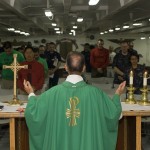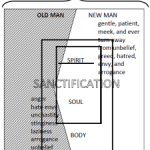By Rev. David Graves
When Jesus saw his mother and the disciple whom he loved standing nearby, he said to his mother, “Woman, behold, your son!” Then he said to the disciple, “Behold, your mother!” And from that hour the disciple took her to his own home. -John 19:26-27 ESV
The question that has been asked is how the above verse is to be understood. I assume the question is posited with the intent of how we understand this verse in the context of a greater theological theme or within the realm of Mariology. Before we can answer any deeper theological meaning we must first understand the immediate and most probable meaning of this verse from John.
Within the context of the Gospel the Apostle John holds Mary in rather high esteem. He does omit the incarnation and nativity accounts, but he shows Mary as being very much involved in Jesus’ life and ministry. She was present and quite active when Jesus performed his first miracle at Cana, but she takes a leave of absence in the gospel up to this point. You could say Mary bookends the ministry of Jesus which would be intentional in the style of the Evangelist. Thus we have this rather specific account of Jesus entrusting his Mother to the beloved disciple. Why did John bother to mention it? One could say that John is the author and this was entrusted to John specifically so it makes sense that he would include it. Also, during the time of Jesus and beyond burial cults were common and would make provisions for widows who could not take care of themselves (keep in mind there is no Social Security or other programs for seniors in the first century AD). The followers of Jesus and the early Church functioned very much in this way. We assume Mary is a widow, Joseph presumed to be dead, and with Jesus going to die soon he needs to make sure she is taken care of. So what we see is a typical arrangement being made on the part of Jesus. Now this raises some questions: Why John and not a ‘brother’ or ‘cousin’ of Jesus? There is mention in Scripture that some of Jesus’ followers were his relatives so why John? John is not a relative of Jesus being the ‘Son of Zebedee’ not ‘Son of Joseph’ or Mary for that matter. In fact Jesus even makes light of this referencing the ‘Sons of Zebedee’ as the ‘Sons of Thunder’ an apparent reference (albeit not so nice) to their mother! Why exactly we may not really know. Yet, this does raise questions to whether or not Mary actually had other children. If John is to take care of her and not her own children in Nazareth we may be able to assume she never had any children beyond Jesus and that indeed Joseph had children from another marriage; but that is all speculation. What we find is that Mary is entrusted to John and he takes her into his own home from that day forward even beyond the Resurrection. So what we have here in essence is a common first century Judean custom of making final arrangements for family members who are not able to take care of themselves. But we are still left with a few implications: Why did John include it? What else could John mean by this?
First, John included it to have a complete account of the life of Jesus since his gospel is supplementary to the Synoptics. John adds a lot of information that Matthew, Mark, and Luke leave out. Yet, in the Gospel of John we find a great deal of ‘double meaning’ i.e. the miracles (signs) and words of Jesus often have two valid meanings behind them. We find this in John chapter 4 when he speaks of proper worship: “Jesus said to her, “Woman, believe me, the hour is coming when neither on this mountain nor in Jerusalem will you worship the Father. You worship what you do not know; we worship what we know, for salvation is from the Jews. But the hour is coming, and is now here, when the true worshipers will worship the Father in spirit and truth, for the Father is seeking such people to worship him. God is spirit, and those who worship him must worship in spirit and truth.” What Jesus is saying here is twofold: 1. God has a specific identity and it is being manifested through him. Jesus reveals God as he truly is; Father, Son (truth), and Holy Spirit (spirit) and when Jesus’ ‘hour’ comes God’s nature will be revealed perfectly on the cross. 2. We also find in this revelation that worship means to keep the commandments, specifically the first commandment. The woman who was a Samaritan did not ‘know’ the God of Israel and was not fulfilling the law in that way, now she had the true identity of God revealed to her so she could indeed do the will of God. We find in this the primary (second) use of the law that she is a sinner in need of God’s grace. The gospel: Jesus is the messiah and reveals to her God’s true nature. And the third use of the law, that is the will of God, to do the commandments which cannot be properly followed unless the first is understood-knowing who God is. Thus in John’s gospel we find a great deal of meaning even in simple encounters with Jesus. I believe then that we have the same situation here in John 19.
So what does the Apostle John and Mary the mother of God represent in this gospel? I think we need to look at the Evangelist’s other writings to grasp this better. Do we have a specific example of Mary in the writings of John the Apostle to represent something with a theological emphasis? Yes! This becomes clear when we look at the book of Revelation, also written by John: “And a great sign appeared in heaven: a woman clothed with the sun, with the moon under her feet, and on her head a crown of twelve stars. She was pregnant and was crying out in birth pains and the agony of giving birth. And another sign appeared in heaven: behold, a great red dragon, with seven heads and ten horns, and on his heads seven diadems. His tail swept down a third of the stars of heaven and cast them to the earth. And the dragon stood before the woman who was about to give birth, so that when she bore her child he might devour it. She gave birth to a male child, one who is to rule all the nations with a rod of iron, but her child was caught up to God and to his throne, and the woman fled into the wilderness, where she has a place prepared by God, in which she is to be nourished for 1,260 days” -Revelation 12:1-6 ESV. According to Dr. Louis Brighton the woman giving birth is Mary, and she is the third of the symbols that represent the Church in Revelation (the other two being the colossal angel with the scroll Revelation 10, and the two witnesses Revelation 11). Therefore we have in the writings of John a specific use of Mary representing the Church and we can infer that the Johannine community would understand this as well reading both the gospel and Revelation together (not as complementary necessarily but having early access to both works), both books giving specific encouragement and comfort during the time of persecution. So what can we infer from this after confirming that John portrays Mary as a symbol of the Church? Our Roman Catholic brothers and sisters would take this to mean Mary is our spiritual mother who we are to take into our hearts and ask for her intercession. They use the wedding at Cana as a reference to Mary interceding to Jesus for help, and indeed she does. Yet for John this is not what he most likely meant. For John, Mary specifically represents the Church not so much her status individually (although it is regarded very highly and above all the saints). What seems more probable is that like John we are to understand the Church as our mother and we are to take part in the Church and even take her ‘home’ to our families so that they may know the gospel of Jesus as well and be converted. We find this in John’s gospel with the example of the Roman Centurion “The father knew that was the hour when Jesus had said to him, “Your son will live.” And he himself believed, and all his household” -John 4:53 ESV. In the first century the household converted as one and the idea of individual conversion without connection to the family was a foreign concept (i.e. American individuality). So John taking home the ‘Church’ was for those who heard the gospel to go and do likewise. Yet the most significant point to be made is that John is standing in for the Apostles at this point (the rest having fled and Peter is hiding in disgrace) and is given the task of the mission of the Church. Jesus entrusts Mary to John the way he entrusts the Church to his Apostles. Therefore Jesus is cognizant and very concerned with the Church’s mission even on the cross and you could say the Church’s mission begins from there and stands as a witness to his resurrection which affirms everything the Church is to do. The point being made here is very significant and shouldn’t be overlooked! This also puts a different understanding on the person of Mary. Instead of Mary protecting the Church as the Roman Catholics would posit; the Church protects Mary. She is to be honored and esteemed by all of us even the saints in heaven and she is entrusted to us the way the Lord entrusts her to John. The Church is to protect her saints and nourish them as well as spread the gospel. Therefore we have a twofold mission of the Church both to evangelize and to feed and nourish those who are in the fold already. This emphasis then can help against the notorious ecclesiastical reductionism we find on either side of the LCMS spectrum: the ‘missionals’ who ignore those or do not value those within our walls and the ultra ‘confessionals’ who like the idea of evangelism but seldom do it. So Mary in a variety of ways teaches us about the Church and she herself is its greatest symbol. I think we can be confident that Mary is indeed the highest of all the saints even higher than the angels since she bore the incarnate word and even that she prays for the Church. However, if we ascribe to her authority or powers beyond that we do run the risk of obscuring the glory and honor and worship to be given to God alone. Yet there is nothing wrong with ‘taking Mary home’ and understanding that praise and honor given her is ultimately what the Church receives as Christ’s bride and perfect partner always preparing for the great wedding and feast to come.














